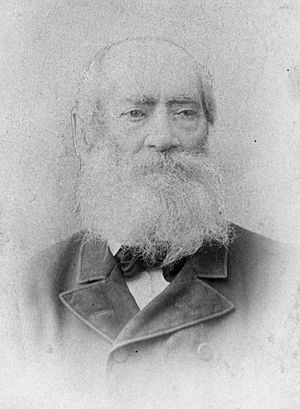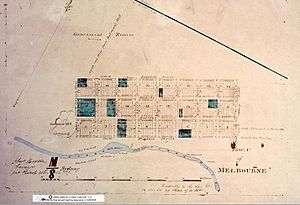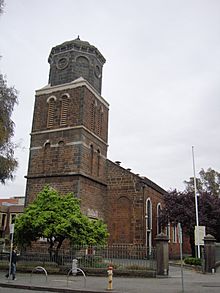Robert Russell (architect) facts for kids
Robert Russell (born February 13, 1808 – died April 10, 1900) was an important architect and surveyor in Australia. He helped plan the city of Melbourne. In 1836, he made the first survey of the land where Melbourne now stands. He also designed St James Old Cathedral, which is the oldest building still standing in central Melbourne. Robert Russell was also a talented artist. His drawings and paintings show what early Melbourne looked like.
Robert Russell's Early Life
Russell was born in London, England. His father was a merchant. Robert had a good education. In 1823, he started learning to be an architect and surveyor in Edinburgh. This was like an apprenticeship. He later worked for a famous architect named John Nash in London.
After that, Russell worked on a large mapping project in Ireland. He found he liked surveying because it gave him more free time. He became curious about Australia and decided to move there.
In 1833, Robert Russell arrived in Sydney, Australia. He had letters of introduction to Thomas Mitchell, who was the head surveyor for New South Wales. Russell soon got a job as an assistant surveyor.
Surveying the City of Melbourne
In 1835, groups of settlers from Tasmania arrived in Port Phillip (now Melbourne). They settled there without official permission. To make things official, the government in London sent William Lonsdale to set up a proper settlement.
Robert Russell was chosen as the surveyor for this new settlement. He had two assistants, Frederick D'Arcy and William Darke. They were told to go to Port Phillip right away. They arrived there in October 1836.
Russell and his team started surveying the area. One day, their horses needed a rest. Russell decided to use this time to survey the future city. He later said:
- "We decided to fill the time by surveying the site of the future settlement."
- "I did the main measurements, Mr. Darke worked along the river, and Mr. D'Arcy drew the plan."
- "It took us about a week to finish."
Russell explained that he chose the city's location based on where the first settlers had built their huts. He wanted to disturb them as little as possible. The old waterfalls on the Yarra River also helped decide the city's spot. The first builders stayed close to these falls.
In May 1837, Russell had to go back to Sydney. Another surveyor, Robert Hoddle, was sent to take his place. Before Hoddle left Sydney, he asked Russell to send him his survey of Melbourne. Russell's plan was based on a general layout for new towns. Russell, D'Arcy, and Darke even went with Hoddle as he made his own survey.
When the first official plan of Melbourne was published, it was named the Hoddle Grid. This was because Robert Hoddle was the colony's surveyor at the time.
Years later, there was a debate about who truly surveyed Melbourne first. After Hoddle died in 1881, a newspaper article gave him credit. Robert Russell wrote a letter to the editor, saying:
- "I never marked any outlines or corners of the city."
- "I was the first surveyor in charge at Port Phillip."
- "Mr. Hoddle used the lines from my survey plan."
In 1899, when he was 91, Russell gave a long interview. He explained that Hoddle had used his survey. He said: "The original plan of Melbourne which I prepared... was sent to my father in England, who had it printed."
Another early settler, Robert Frost, also said that Russell was the first to plan the city. However, some people, especially Hoddle's family, believe Hoddle deserves the credit. They say Hoddle added the squares, park lands, and exits from the city. The debate about who made the original survey of Melbourne continues even today.
Later Life and Artistic Work
In 1839, Robert Russell designed St James Old Cathedral. It is the oldest building in Melbourne. It was moved just outside the city center in 1914. It is one of the few buildings left from before the Gold Rush era.
Russell worked as an architect in Melbourne until he was very old. He died in Richmond, Melbourne, in 1900, at the age of 92. He had two sons and two daughters.
Besides being a surveyor and architect, Russell was also a talented artist. He made many sketches, photographs, and etchings. His artwork is very important because it shows what Melbourne looked like in its early years. He used both watercolors and pencils. His art can be found in major libraries and galleries in Australia, like the State Library of Victoria and the National Gallery of Victoria. A portrait of him was painted around 1890 by Frederick McCubbin.
In 1969, a group of architects in Victoria named their building 'Robert Russell House'. This was to honor his important work.




